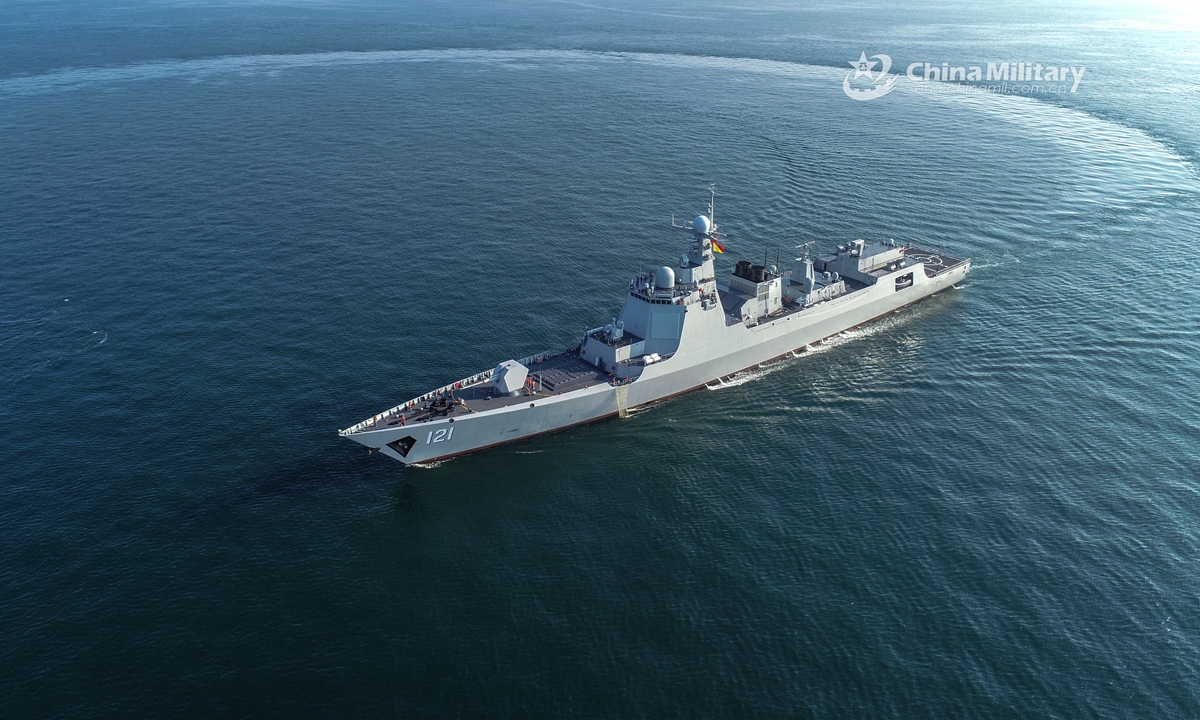
The guided-missile destroyer Qiqihar (Hull 121) attached to the navy under the PLA Northern Theater Command steams forward during a maritime training exercise in mid December, 2020. (eng.chinamil.com.cn/Photo by Zhang Hailong)
A Chinese People's Liberation Army (PLA) Navy flotilla led by a Type 052D destroyer on Thursday started participating in a multinational exercise in Pakistan, a unique platform experts said that provides opportunities for Chinese and Russian navies to come together with their counterparts from the US and other Western countries.
Invited by the Pakistan Navy, the PLA Navy 119 Flotilla arrived in waters close to Karachi, Pakistan on Thursday to participate in the multinational exercise AMAN-21, after the flotilla wrapped up its escort mission in the Gulf of Aden, the PLA Daily reported on Friday.
The 119 Flotilla, led by the Type 052D guided missile destroyer Guiyang and consisted of also the Type 054A guided missile frigate Zaozhuang and the Type 903A comprehensive supplement ship Dongpinghu, was the 36th escort task force to the Gulf of Aden setting out from Qingdao, East China's Shandong Province on September 3, 2020, and completed a handover ceremony to the 37th escort task force on January 31 in the Gulf of Aden after completing 38 escort missions on 52 ships around the region, the PLA Navy announced in a statement released on February 1.
The Global Times learned from the Pakistan Navy on Friday that the AMAN-21 exercise is scheduled in two phases: the harbor phase and the sea phase. The harbor phase will comprise of the International Maritime Conference, seminars, table talks, cross ships visits, calls on and the International Band Display and Maritime Counter Terrorism Demonstration, while the sea phase includes practical execution of operational plans and activities finalized during the harbor phase.
The exercise has been planned with focused objectives, which include enhancing interoperability with regional and extra-regional navies thereby acting as a bridge between the regions, and the display of united resolve against terrorism and crimes in the maritime domain, according to the Pakistan Navy.
Naval forces from more than 40 countries, including those from Russia, and the US as well as some other NATO countries will also participate in the exercise, foreign media reported.
This is the eighth time the PLA Navy has participated in the Pakistan Navy-initiated AMAN series multinational exercises, which aim at enhancing professional communication and friendly interactions with other navies, the PLA Daily said.
The drill comes after increased military tensions between China and the US in regions like the South China Sea and the Taiwan Straits since the start of the COVID-19 pandemic and former US president Donald Trump's play of military cards on China, and it also marks the first known time China and the US have been in the same military exercise since US President Joe Biden assumed office in January, a Chinese military expert who asked to remain anonymous told the Global Times on Friday.
In November 2020, the Chinese and US militaries held a three-day online seminar on humanitarian assistance and disaster reduction, and this time the two militaries can get the chance to operate together, get to know each other better and build up mutual trust, when misunderstanding was on the rise over the past few months, the expert said.
It is also a rare occasion in which Russia joins an exercise together with NATO countries, analysts said.
The exercise this time is unique in a sense that it provides an opportunity to navies from China, Russia and the US and other Western navies to come under one platform, an officer from the Pakistan Navy told the Global Times on Friday on the condition of anonymity.
AMAN represents a "bridge" that allows several countries to meet and operate through their naval forces being with each other, even though there may not be open relationships between a few nations due to various politico-strategic differences, the Pakistani officer said, noting that this exactly was the role that Pakistan had played back in the 1960s-70s, by acting as a link between the East and the West, when the China-US barrier was broken and a new bond was established.




